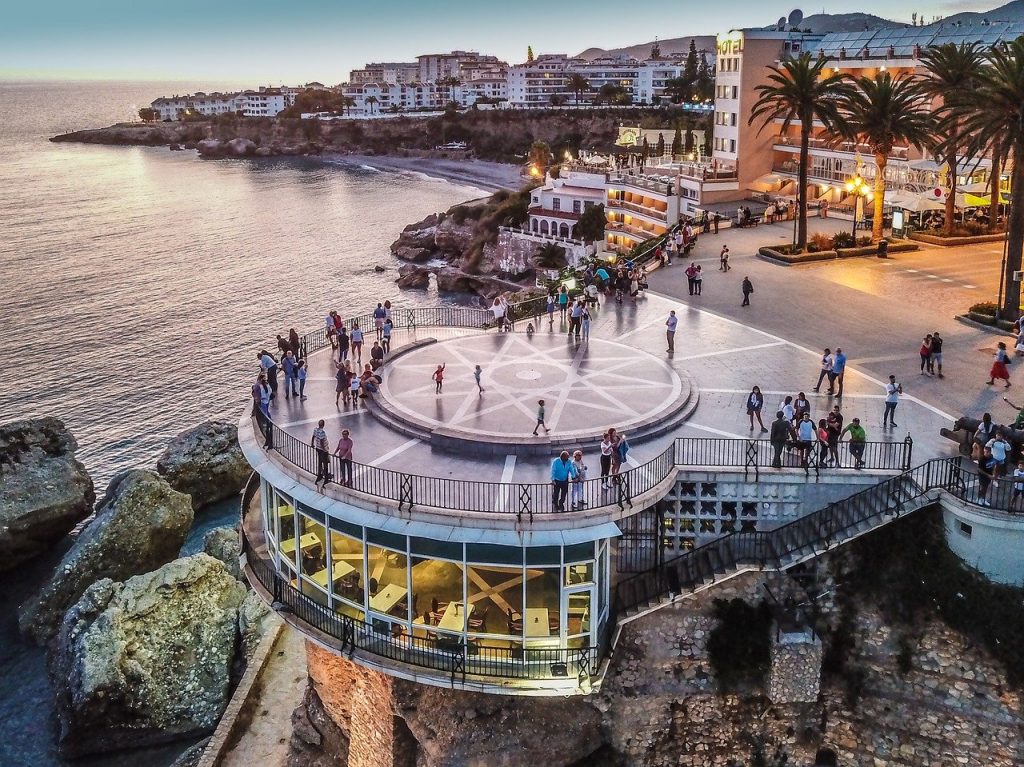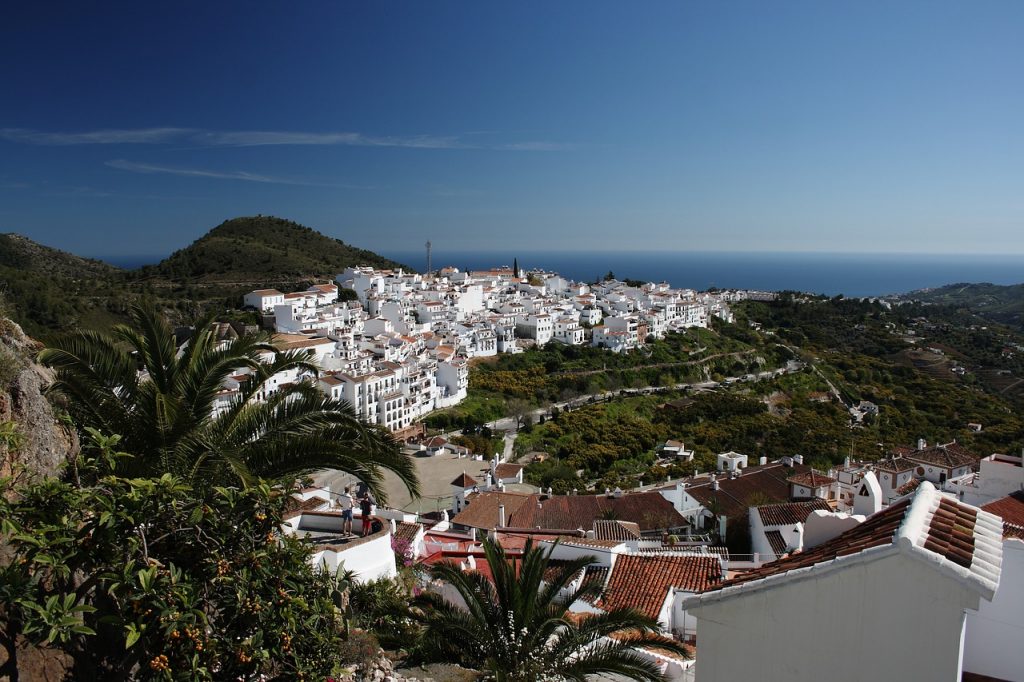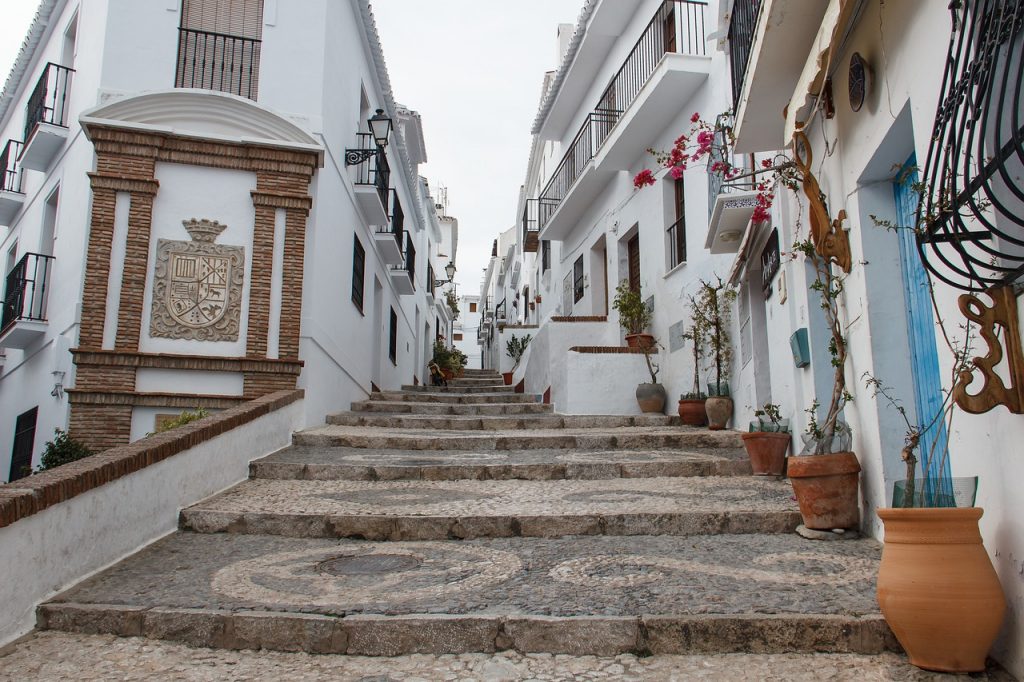La Axarquía, east of Málaga, has the best of both worlds with mountains and sea providing natural areas in abundance. From the coast’s fishing villages to the white villages crowning mountain peaks, it’s not far from Málaga airport, yet without the overblown tourism of the west of Málaga. In part 2, we visit Nerja and Frigiliana.
Bordering the province of Granada, Nerja is a fishing village that has grown into a slightly larger tourist town. And yet, it retains its charm. The plazas are quaint and the old town is still whitewashed houses and winding cobbled streets.
The Balcony of Europe

In the heart of Nerja town is the Balcón de Europa (Balcony of Europe) with wonderful views across the Mediterranean Sea. A fort used to stand there and it was known as the “Paseo de la Batería”. An earthquake in 1884 destroyed the fort and the then king Alfonso XII renamed it the Balcón de Europa.
On either side is a beach – Calahonda to your left and Caletilla to your right. From Calahonda, you can walk around the rocks to other beaches. You can even walk to Burriana beach where you can rent a kayak and visit the Maro cliffs.
Prehistoric caves of Nerja

Whilst the centre of Nerja has a certain charm which entices tourists, the area has been a draw since prehistoric times.
The famous caves of Nerja are in Maro, a district of Nerja. Discovered in 1959 by a group of young locals who were on a late-night walk searching for bats, they are some of the most important caves in the world.
The caves are home to what was the oldest work of art known to man. The art is out of bounds for visitors but the impressive rock formations make the caves a wonder to behold.
Concerts are also held in the caves which has incredible acoustics.
Frigiliana

One of the most beautiful towns in Spain, as countless surveys attest to, Frigiliana is a short, yet winding drive up the hill from Nerja. The views from the village are outstanding to the sea.
As you enter the town, you’ll notice a three-sided fountain on a roundabout. Each of the sides represents one of the Muslim, Christian and Jewish religions. Frigiliana is proud of the Andalucian heritage that at one time saw the three cultures exist peacefully side-by-side.
In fact, a highlight of the Axarquía calendar is the Trés Culturas Festival in August. Days and nights of live music, markets, a tapas route and a chance to explore the town’s heritage make it a must-do experience.
The tapas tour is an excellent way to discover the different areas of the town. From the Barribarto, the old Moorish neighbourhood – also the most beautiful part of town – to the newer outskirts, it is a picturesque place to visit.
A long and sometimes bloody history

Settled around 3,000BC, the Romans named Frigiliana as Frexiniusana. They fortified the town and built a hilltop castle Castillo de Lizar. You can see the remains of the castle today. With the advent of the Moors around 711, the town grew.
Frigiliana produced mostly oil, sugar cane, raisins, figs, and silk which made the local economy prosperous. The Moors built irrigation systems and terraces to boost farming activities.
For centuries the Muslim, Christian and Jewish cultures existed peacefully side by side. Then, around 100 years after the Christian reconquest, there was bloodshed.
In 1569, the Battle of Peñon de Frigiliana saw the deaths of over 2,000 Muslims and 500 Christians. Six to seven thousand Muslims took refuge in the fortress, though they were barely armed. They resisted for some time before reinforcements arrived and one of the bloodiest battles the south of Spain has witnessed took place. Muslim women fought alongside their men. More than half the deaths on the Muslim side were women and children.
Frigiliana became a ghost town. Slowly, the Christians repopulated the area and continued many of the economic activities the Moors started.
What to see and do in Nerja and Frigiliana
For an insight into Frigiliana’s history, head to the Palacio de los Condes (El Ingenio), the town’s Archaeology Museum, the church of Saint Anthony of Padua and stroll through the town’s old quarter.
The towns of Nerja and Frigiliana are fantastic for relaxing days out, beach holidays, history buffs and those who like to hike the beautiful natural park surrounding these key towns of La Axarquía.


